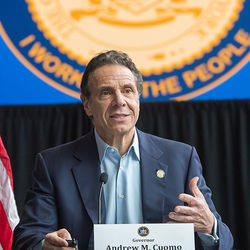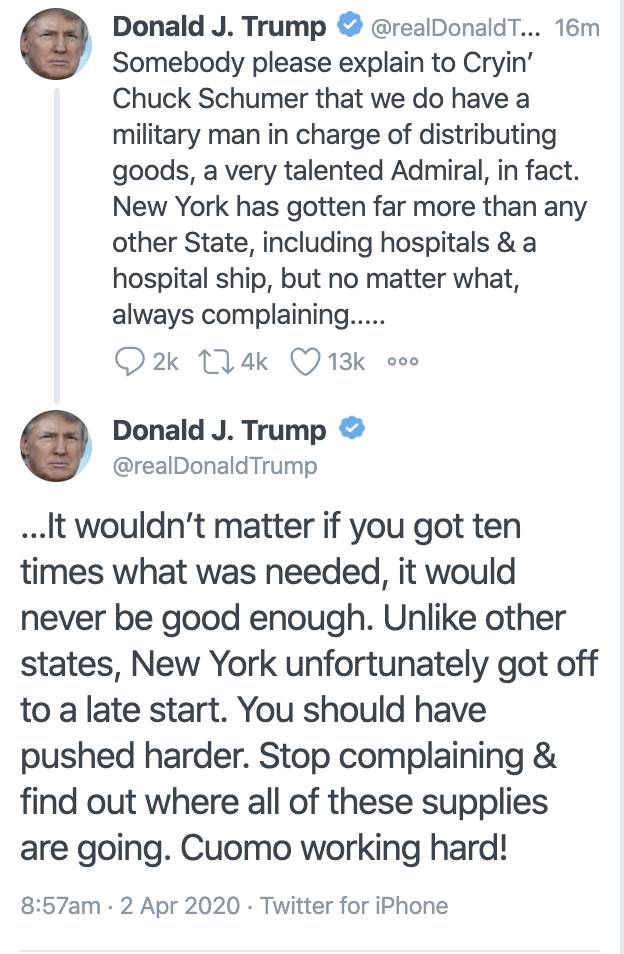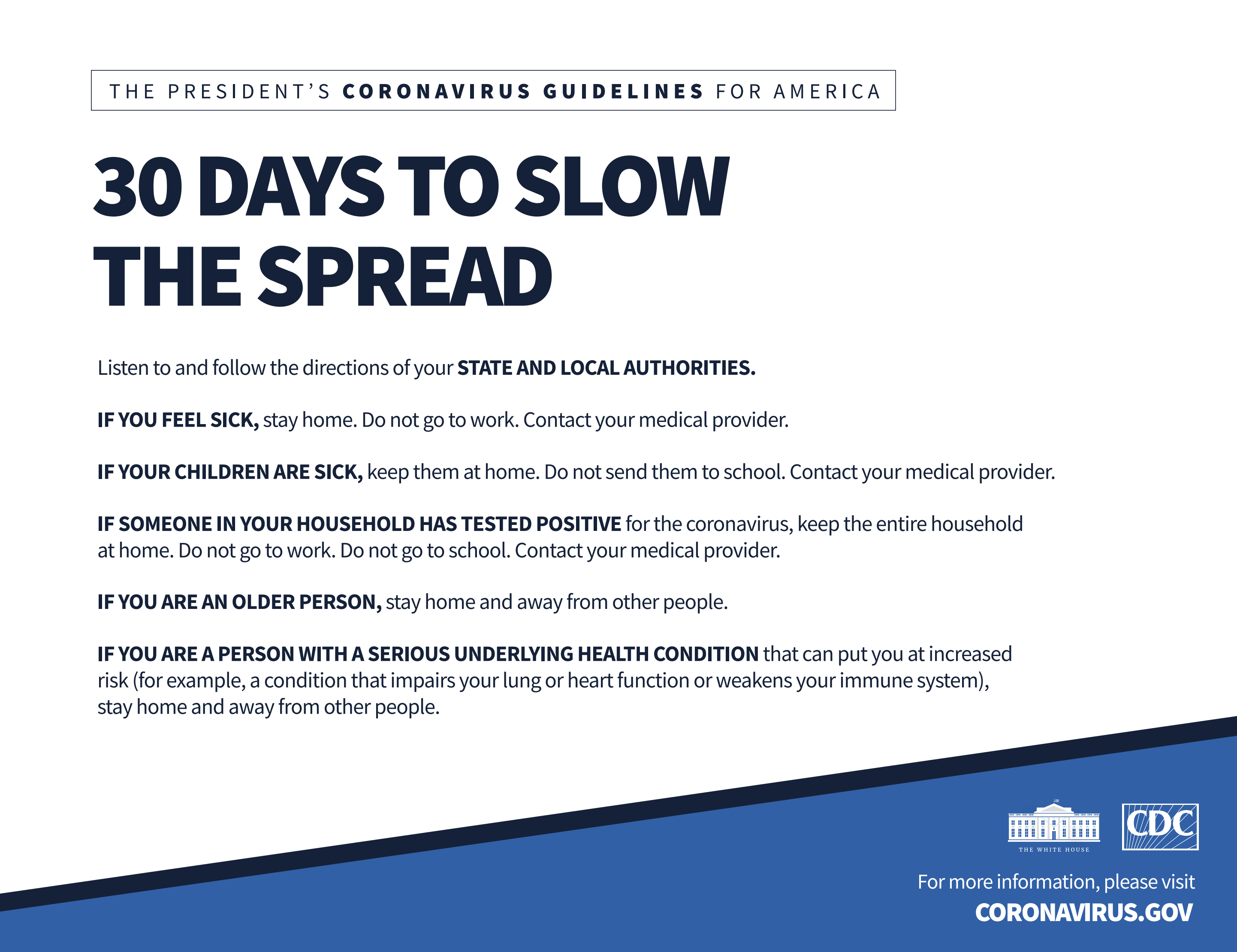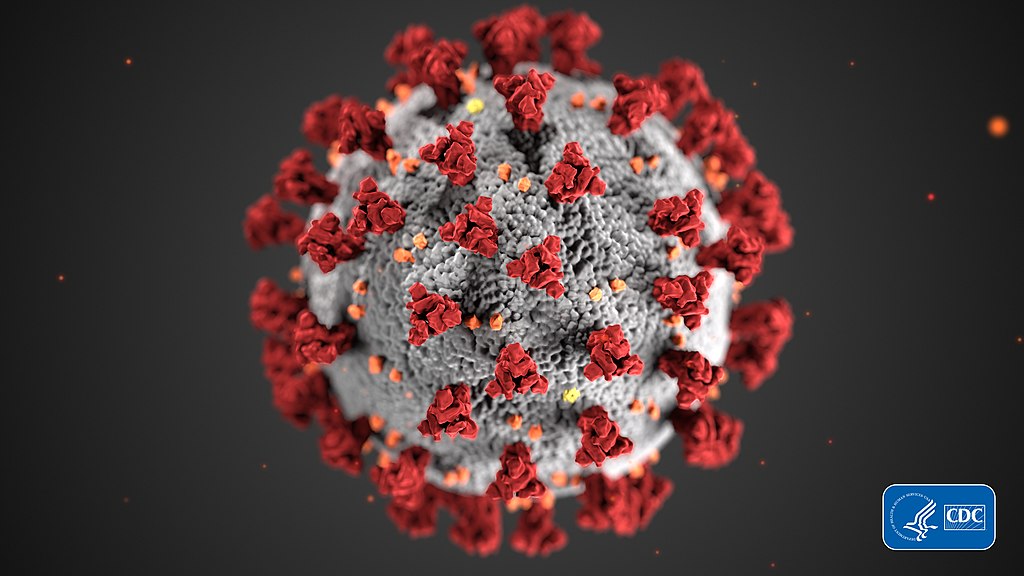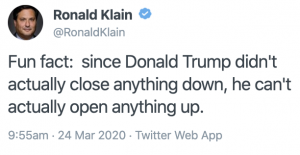Court transcribers like Peter Baker and Mike Allen were very impressed with what they deemed a very somber new Donald Trump in yesterday’s COVID rally. At it, Trump warned that we’re going to have a hard two weeks ahead of us (and then, over an hour later, admitted in an offhand comment it might actually be three). He warned there were going to be a lot of deaths — then stepped aside so someone not up for election could explain that means upwards of 100,000 deaths. And so, Trump implored while promising everything would get better in two weeks (or maybe three), we need to follow White House 30 Days to Slow the Spread guidelines to ensure we can limit deaths to 100,000.
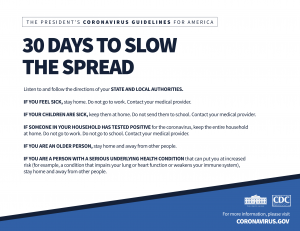
There are a couple of major problems with that.
First, those guidelines ask for 30 days, but Trump is just asking for two more weeks (or three, if you manage to watch over an hour of this stuff).
Then, as Dr. Deborah Birx noted repeatedly, that 100,000 best case scenario is based off the IHME projections. But the IMHE projections are based off adopting a more stringent level of social distancing than White House 30 Days to Slow the Spread guidelines — basically, stay at home orders — and they assume those orders will remain in place until the end of May, not April.
To be fair, starting before the time Trump was pushing to reopen the economy, a bunch of governors (most of them Democrats, including people like Jay Inslee, whom Trump has repeatedly attacked) decided to impose more stringent requirements than Trump was recommending. As of yesterday, 29 Governors had stay-at-home measures in place to match the IMHE projections. Republican die-hards Doug Ducey of Arizona and Greg Abbott of Texas even capitulated yesterday and imposed state-wide orders (though on second review Abbott’s is just a non-essential business closure).
But even as this presser was going on, Trump’s closest ally among the governors, Ron DeSantis, was digging in, claiming that the White House task force had never suggested to him that they should impose a stay-at-home.
“I’m in contact with (the White House task force) and I’ve said, are you recommending this?” DeSantis said. “The task force has not recommended that to me. If they do, obviously that would be something that carries a lot of weight with me. If any of those task force folks tell me that we should do X, Y or Z, of course we’re going to consider it. But nobody has said that to me thus far.”
Trump was even asked about this. In a presser where Trump and Birx suggested that New York had been really late in adopting social distancing (that’s not true: Andrew Cuomo imposed an order more stringent than Trump’s current guidelines on March 18, just two days after Trump first called for social distancing, and imposed a full stay-at-home on March 20, effective March 22, which was among the earliest full state shut-downs), Trump and Mike Pence also had nice things to say about DeSantis, with Georgia’s Brian Kemp, the last of the major state governors not have one.
Reporter: I wanted to ask you about individual states issuing stay at home or what do you think, for instance, in Florida, Ron DeSantis has resisted urges to issue one of those, but he said moments ago that if you and the rest of the task force recommended one, that would weigh on him heavily. What sort of circumstances need to be in place for you to make that call and say this is something you should consider?
Trump: Different kind of a state, also great Governor, knows exactly what he’s doing, has a very strong view on it, and we have spoken to Ron. Mike, you want to just to tell him a little bit about that.
Pence: Well, let me echo our appreciation for Governor DeSantis’ leadership in Florida. He’s been taking decisive steps from early on and working closely with our team at the federal level. But let me be very clear on this. The recommendation of our health experts was to take the 15 days to slow the spread, and have the President extend that to 30 days for every American. Now, that being said, we recognize that when you’re dealing with a health crisis in the country, it is locally executed by healthcare workers, but it’s state managed. And so we continue to flow information to state governors. We continue to hear about the data that they’re analyzing and consult with them. But at the President’s direction, the White House Coronavirus Task Force will continue to take the posture that we will defer to state and local health authorities on any measures that they deem appropriate. But for the next 30 days, this is what we believe every American and every state should be doing at a minimum to slow the spread.
Trump: So, unless we see something obviously wrong, we’re going to let these governors good. Now, it’s obviously wrong, I mean, people can make things, they can make a decision that we think is so far out that it’s wrong, we will stop that. But in the case of DeSantis, there’s two thoughts to it, and two very good thoughts to it, and he’s been doing a great job in every respect, so we’ll see what happens. But we only would exercise if we thought somebody was very obviously wrong.
Aside from some rural states and Georgia, just about the only entity in the country not telling DeSantis to shut his state full of especially vulnerable seniors down is the President.
According to the IHME projections (and assuming those aren’t hopelessly optimistic because of a known lag of test results in places like California), we might still make that 100,000 projection if DeSantis imposes a true lockdown within seven days. But he says he’ll only do that if President Trump gives him political cover to do so.
Effectively, then, the allegedly sober President yesterday said we might only have 100,000 deaths if people ignore him and one of his closest political allies, Ron DeSantis.
Update: DeSantis is announcing a stay-at-home order within the hour.

